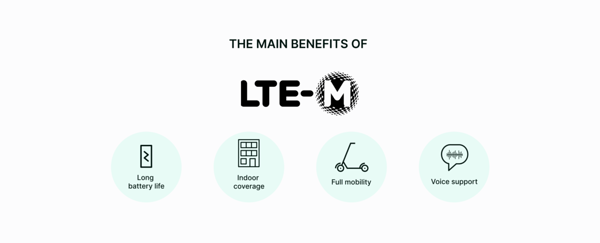LTE-M (abbreviation for LTE Cat-M1/M2) is an alternative LPWAN technology and shares a few qualities with NB-IoT (Narrowband IoT). LTE-M was created for IoT devices to connect directly to a 4G network without a gateway and using only batteries.
It's important to note that LTE-M is a build-up on 4G, but that doesn't mean that any 4G device automatically supports LTE-M. However, LTE-M can perfectly co-exist with 2G, 3G, and 4G and benefits from all mobile networks' security and privacy features.
The difference between LTE CAT-M1 and LTE CAT-M2
The main difference comes in terms of data transmission bandwidths. While LTE Cat-M1 transmits data at a bandwidth of 1.4 MHz, LTE Cat-M2 has increased it to 5 MHz. This raises LTE Cat-M2 data throughput to peak rates of 4Mb/s for downloads and 7Mb/s for uploads, broadening the appeal of LTE-M even for relatively high data speed applications such as video surveillance.
As an advantage for LTE CAT-M2, at these download and upload speeds, it will also be much faster to deliver remote firmware updates over the air (OTA) than it was with LTE CAT-M1 or would be with NB-IoT, limiting drain on the battery.
The difference between 4G and LTE-M
LTE-M is basically 4G adapted to better suit IoT devices. For example, LTE-M offers more energy efficiency, as it can send data to the network with smaller battery consumption. Thanks to this, devices using LTE-M often boast up to 10 years of battery life. This makes it perfect for IoT devices that need to be connected all the time, like e-bikes and other moving devices. You can read more about LTE-M’s power-saving mode here.
Compared to 4G, LTE-M also offers better deep coverage, meaning it can get a stronger connection indoors or underground. However, like NB-IoT, LTE-M doesn’t offer great roaming capabilities, as it’s not as widely available as 4G.
SMS capabilities
LTE-M, introduced in 3GPP Release 13, is fully capable of SMS support in both MO and MT directions. It can be deployed consistently with the existing implementation of SMS over legacy and LTE networks (2G, 3G, 4G).
Mobility
When the device moves away from a cell tower, it increases the device's power consumption to try to connect until it is entirely in the dark. Once disconnected, the device must re-register with the network, increasing power consumption.
LTE-M works like 4G and supports seamless switching between cell towers while saving power. It supports full mobility and in-vehicle handover, meaning it's well-suited for mobile use cases with medium data rate needs, such as vehicle and asset tracking, fleet management, etc.
LTE-M versus NB-IoT
LTE-M, just like NB-IoT, is an alternative LPWAN technology. This technology is created for IoT devices to connect directly to a 4G network without a gateway and using only batteries. However, compared to NB-IoT, LTE-M poses fewer limitations for your deployments:
- For example, since NB-IoT is incapable of cell tower handover, it's only suitable for stationary devices. On the other hand, LTE-M is suitable for both stationary and mobile devices.
- Both LTE-M and NB-IoT technically support eSIM. However, since NB-IoT specification doesn't have SMS services as a requirement, these devices might be unable to download eSIM profiles.
LTE-M supports voice functionality via VoLTE (voice over LTE) and can be used for applications requiring human interaction. Unfortunately, that can't be said about NB-IoT, which doesn't support voice functionality.




